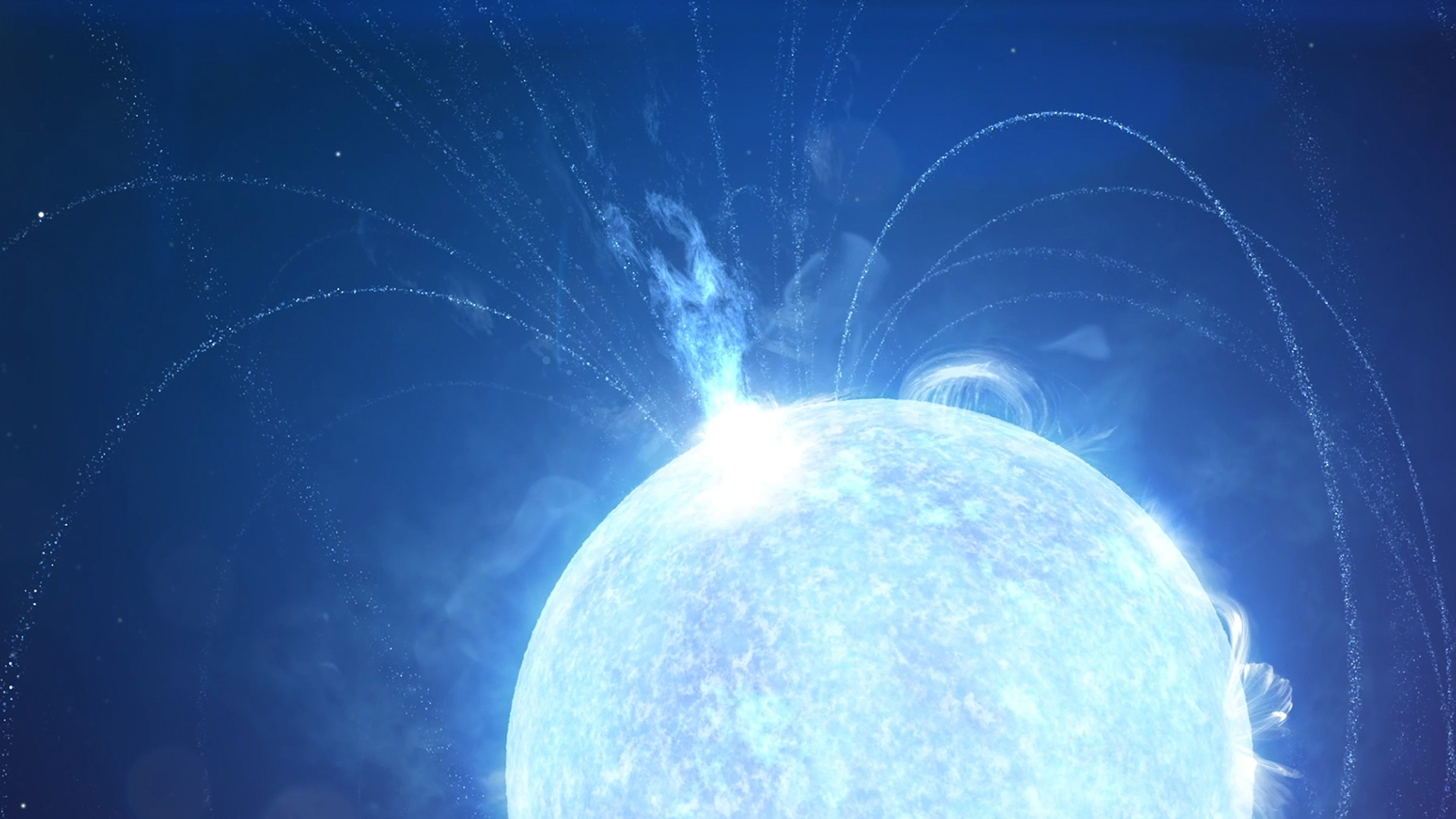Massive, volcano-like eruption may explain dead star's mysterious slowdown
A volcano-like eruption on the surface of a dead neutron star could explain its sudden slowdown and the slew of fast radio bursts that followed

The fast-rotating husk of a dead star mysteriously slowed down, and astronomers think it's because of an "anti-glitch" that caused a gigantic volcano-like explosion from its surface.
The dead star, a magnetar classified as SGR 1935+2154 and located 30,000 light-years from Earth, suddenly decelerated in October 2020 before releasing a month-long barrage of radio waves. Now, a new study, published Jan. 12 in the journal Nature Astronomy, has revealed the likely cause: a massive eruption from the star corpse's surface.
Magnetars, and their less-magnetized cousins pulsars, are special types of neutron stars, which are ultradense remnants from the explosive deaths of stars. Compacted by intense gravitational forces to just a dozen miles wide while being as dense as an atom's nucleus, pulsars and magnetars have unusually strong magnetic fields that are often millions or trillions of times more powerful than Earth's. As the burnt-out stars spin rapidly in space — making a complete rotation once every few seconds — they sweep out a beam of intense electromagnetic radiation from their poles like giant lighthouses. The composition of their surfaces largely remains a mystery.
Related: Strange 'heartbeat' signal spotted coming from deep space
"People have speculated that neutron stars could have the equivalent of volcanoes on their surface," lead author Matthew Baring, an astrophysicist at Rice University, said in a statement. "Our findings suggest that could be the case and that on this occasion, the rupture was most likely at or near the star's magnetic pole."
Astrophysicists study magnetars through the intense radiation they emit in the form of X-rays, radio waves and gamma-rays. For instance, as these rays head our way whenever a magnetar swings around to face us, studying the gaps between the X-ray pulses gives scientists a reliable measure of how fast a magnetar is spinning. Sometimes, these gaps between pulse trains decrease — indicating that a glitch, caused by a sudden change in the dead star's structure, has made it spin faster.
"In most glitches, the pulsation period gets shorter, meaning the star spins a bit faster than it had been," Baring said. "The textbook explanation is that over time, the outer, magnetized layers of the star slow down, but the inner, non-magnetized core does not. This leads to a buildup of stress at the boundary between these two regions, and a glitch signals a sudden transfer of rotational energy from the faster spinning core to the slower spinning crust."
Sign up for the Live Science daily newsletter now
Get the world’s most fascinating discoveries delivered straight to your inbox.
Many spin-up glitches have been observed before, but SGR 1935+2154's spin-down "anti-glitch" — which caused the star to slow down rather than speed up — is the third of its kind ever to be observed, and has so far defied explanation.
What's more, the sudden slowdown was followed by three fast radio bursts (FRBs) — ultrabright flashes of radio energy that can last just a few milliseconds — and a month-long series of radio pulses. Upon arriving at Earth, the radio emissions were picked up by China's Five-hundred-meter Aperture Spherical Telescope and marked the first time that any fast radio burst had been tracked to its source.
To get a better handle on what could have caused the stellar corpse to slow its spin, the researchers built a model that explained the anti-glitch's origin as an enormous and sudden eruption on the star's surface. The surface plasma from a region near one of the star's magnetic poles spewed outward, forming a charged particle wind that interfered with the magnetar's magnetic field and thus acted as a jolting brake against its rotation.
"A strong, massive particle wind emanating from the star for a few hours could establish the conditions for the drop in rotational period," Baring said.
The researchers think the eruption that caused the slowdown is also responsible for the intense radio emissions detected in its aftermath. But to be sure, they'll need to spot another magnetar throwing a cosmic tantrum.
"Given the rarity of spin-down glitches and radio signals from magnetars, their approximate synchronicity suggests an association, providing pivotal clues to their origin and triggering mechanisms with ramifications to the broader magnetar and FRB populations," the researchers wrote in the paper.

Ben Turner is a U.K. based staff writer at Live Science. He covers physics and astronomy, among other topics like tech and climate change. He graduated from University College London with a degree in particle physics before training as a journalist. When he's not writing, Ben enjoys reading literature, playing the guitar and embarrassing himself with chess.









